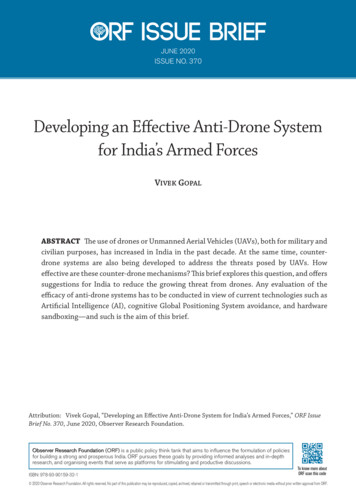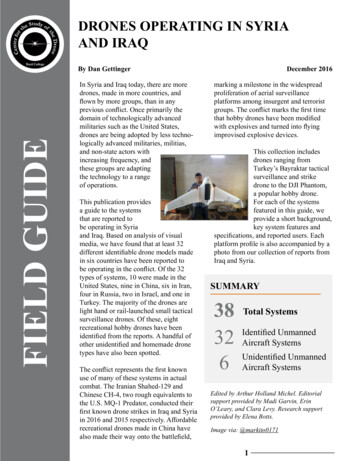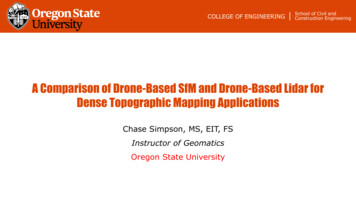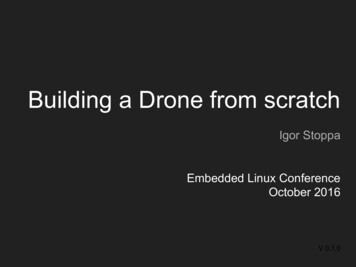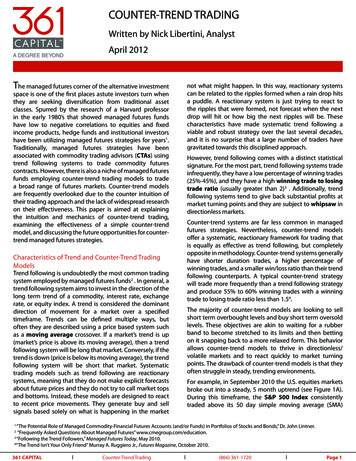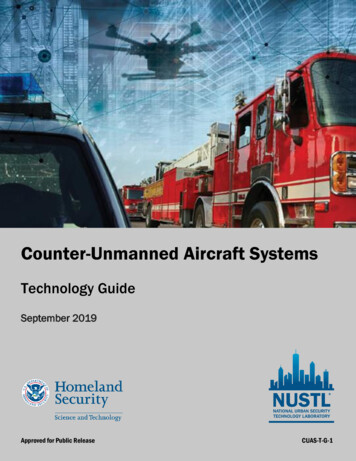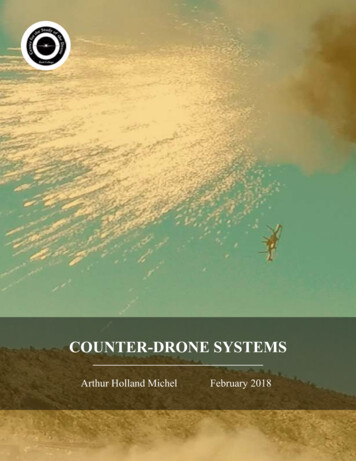
Transcription
COUNTER-DRONE SYSTEMSArthur Holland MichelFebruary 2018
ABOUT THE CENTER FOR THE STUDY OF THE DRONEThe Center for the Study of the Drone at Bard College is an interdisciplinary research institutionthat examines the novel and complex opportunities and challenges presented by unmannedsystems technologies in both the military and civilian sphere. By conducting original, in-depth,and inquiry-driven projects, we seek to furnish stakeholders, policy-makers, and the public withthe resources to engage in a robust public debate and develop policies that best address thoseopportunities and challenges.Edited by Dan Gettinger. Editorial support provided by Karin Roslund. Research support providedby Aasiyah Ali, Lynn Barnett, Dylan Sparks, Josh Kim, and John McKeon. Presentation by DanGettinger.Michael Blades, Senior Industry Analyst, Frost & Sullivan, provided assistance in the developmentof this database. Frost & Sullivan’s market reports on C-UAS technology are available for purchasehere (defense) and here (commercial).Holland Michel, Arthur. “Counter-Drone Systems.” Center for the Study of the Drone at BardCollege, Feburary 20, 2018, .Copyright 2018 Center for the Study of the Drone at Bard College
CSD Counter-Drone SystemsINTRODUCTIONCounter-drone technology, also known as counter-UAS,C-UAS, or counter-UAV technology, refers to systemsthat are used to detect and/or intercept unmannedaircraft. As concerns grow around the potential securitythreats drones may pose to both civilian and militaryentities, a new market for counter-drone technology israpidly emerging. To date, we have found at least 235counter-drone products either on the market or underactive development. This report provides background onthe growing demand for C-UAS technology, describeshow the technology works, presents our database ofknown C-UAS systems from around the globe, andexplains some of the challenges surrounding counter-drone technology use.KEY TAKEAWAYS The C-UAS industry has grown exponentially inrecent years. We have identified over 230 C-UASproducts produced by 155 manufacturers in 33countries; The most popular drone detection techniquesare radar, RF detection, EO, and IR. The mostpopular interdiction technique is jamming; C-UAS technology poses a wide range ofpractical, legal, and policy challenges in alloperating environments; A lack of common standards in the C-UASindustry means that there is a wide variance inthe effectiveness and reliability of systems.BACKGROUNDMilitary groups have pondered the issue of how tocounter unmanned aircraft for several years. For example, in 2003, NATO launched a ten-year study on how todefend against low, slow, and small aerial targets usingground-based defense systems (the resulting report hasnot been publicly released). In 2008, RAND Corporation published a seminal report on the threat posed byunmanned aircraft to the U.S., which helped define thecontours of the topic.1 In the ensuing years, a wide rangeof organizations, labs, and private firms have weighed inon the threat of unmanned aircraft and what to do aboutit.The growth of C-UAS technology is directly tied tomounting concerns about the threat thatdrones pose both in civilian and wartimeenvironments. In the military domain, smalldrones have been proliferating at a rate thathas alarmed battlefield commanders andplanners alike. In the conflict in Syria andIraq, at least half a dozen groups operatea wide variety of drones, which give eventhe most poorly funded actors an aerialcommand of the battlespace that can provedecisive in engagements.2 For example, ISIShas used drones to help guide vehicle-borneIEDs more accurately toward their targets.Some of these same groups have successfully armed drones with explosive ordnance, effectively converting cheap hobbykits into rudimentary yet potentially lethalguided missiles. Last year, ISIS claimed to1have carried out more than 200 such attacks in just 12months.3 In January, an unknown group launched overa dozen such drones in a coordinated attack againsttwo Russian military installations in Syria.4 Though theoffensive was ultimately unsuccessful, it demonstratedthe growing sophistication of the unmanned aircraft thatare increasingly finding their way into war zones acrossthe globe. Even when these attacks are unsuccessful,they still create serious challenges for belligerents on theground and in the air; there are so many drones operatingin the conflict in Syria and Iraq that one Army officialeven said that the U.S. has no control of the airspacebelow 3,500 feet in the area.5 The conflict in Ukraineis another important case study on the impact of smallunmanned aircraft in modern warfare.6A still from an ISIS promotional video shows an armed Skywalker X-8 fixed-wing drone.dronecenter.bard.edu
CSD Counter-Drone SystemsMany worry that similar drones could be used in terrorist attacks domestically.7 In 2013, Germany’s PirateParty flew a small multirotor drone in close proximityto Angela Merkel at an open-air rally, leading manyto speculate about the ease with which a drone couldattack an otherwise highly secured area.8 Sightings ofdrones over sensitive facilities such as a submarine basein Washington State9 and nuclear facilities in France10have raised the specter state- and non-state-sponsoredespionage. Other concerns are no longer hypothetical.Around the globe, drones have become a popular toolfor smuggling contraband into prisons. Meanwhile, nearmisses between drones and manned aircraft have becomea common occurrence in every crowded airspace systemin the world, and many worry that a collision between amanned aircraft and an unmanned aircraft could result ina catastrophic accident.11The air defense systems that have traditionally been usedto protect airspace from manned aircraft are generallyineffective against drones. Military anti-aircraft radarsare mostly designed to detect large, fast moving objects.As a result, they cannot always pick up small, slow,low-flying drones. Furthermore, since unmanned aircraftare cheap, it is impractical to use traditional anti-aircraft weapons, which can cost hundreds of thousandsof dollars per unit, to shoot them down. Even formidable air defense systems have sometimes failed to bringdown rudimentary unmanned aircraft; in July 2016, asimple Russian-made fixed wing drone that flew intoC-UAS PRODUCTS AT-A-GLANCENumber of C-UAS products235Number of manufacturers155Systems capable of detection only88Systems capable of interdiction only80Of both detection and interdiction67(Above) An Immersion Vortex 250 drone is downedby a water cannon at the 2016 AFRL Commander’sChallenge, a counter-UAS exercise. Photo by WesleyFarnsworth.2Israeli airspace from Syria survived two Patriot missileintercepts, as well as an air-to-air missile attack froman Israeli fighter jet. In civilian airspace, drones aren’trequired to carry transponders, so they cannot be detected and tracked with existing air traffic control systems.Relying on visual observation to detect drones is equallyineffective; at a distance of several hundred feet, dronescan become all but invisible to the naked eye.MARKET GROWTHThe growth in the counter-drone technology sector isdirectly correlated to these concerns. The U.S. Department of Defense significantly increased investment inC-UAS technology only after ISIS and other groupsoperating in the conflict in Syria and Iraq demonstratedthe ability to operate a wide range of drones, includingarmed systems. In 2015, after a man accidentally crasheda DJI quadcopter on the grounds of the White House,revealing that the nation’s most protected site could bevulnerable to attacks from unmanned aircraft, the SecretService began testing C-UAS systems and techniques inD.C.13 Following hundreds of reports of close encountersbetween drones and manned aircraft in the U.S. airspacesystem, the FAA launched a program to test C-UAS at anumber of airports, where such incidents are both mostcommon and most dangerous.14 After law enforcementgroups raised the possibility that drones could be aneffective weapon for terrorist attacks on large crowds,counter-drone systems began to appear around sportingand political events with increasing regularity.The expansion of the sector in the roughly five yearssince counter-drone systems first appeared on the markethas been stratospheric. In a market survey conducted in2015, researchers at the Sandia National Laboratoriesidentified just 10 dedicated counter-drone systems available for acquisition.15 Today, less than three years later,we have tallied over 200 systems on the market. Venturecapital firms have also taken an interest in the sector, andcounter-drone technology acquisition and developmentis now the fastest-growing drone-related spending category in this year’s Department of Defense budget.16 Onestudy estimates that the C-UAS market could be worthas much as 1.5 billion in five years.17@DroneCenter
CSD Counter-Drone SystemsHOW C-UAS IS USEDCounter-drone technology has already seen extensive use in certain applications. On the battlefield,C-UAS systems have so far most commonly been used for base protection, complementing existingweapons such as counter-mortar systems and surveillance platforms. There is also growing interest inportable and mobile systems that could be used to protect ground units and convoys. In civilian environments, counter-drone technology has so far primarily been used for airspace protection at airports, security during large events such as party conventions and sports games, VIP protection, and counter-smuggling operations at prisons.18 Future common applications could include airspace defense around sensitivefacilities, port security, maritime security, and personal use over private property.EXAMPLE USE CASESBoston Marathon 2015,2016, 2017, USAJohn F. Kennedy International Airport, USA2017 U.S. PresidentialInaugurationOffutt Air Force Base,USAPort of Galveston, USA3Muhammad Rasulullah 4Exercises 2016, IranLes Nicolles Prison, U.K.2016 Warsaw Summit(NATO), PolandMonaco Police, MonacoRio de Janeiro OlympicGames 2016, BrazilWorld Economic Forum2017, 2018, SwitzerlandGuangzhou Baiyun International Airport, ChinaNew Delhi Republic Day2018, IndiaWuhan Police, ChinaU.S. Forward OperatingBases, Syria/IraqDubai International Airport, DubaiFuneral of BhumibolAdulyadej, ThailandSingapore Home Affairs,Singaporedronecenter.bard.edu
CSD Counter-Drone SystemsC-UAS 101Different C-UAS systems rely on a variety of techniques for detecting and/or intercepting drones. This page describes themain detection and interdiction methods employed by products currently available on the market.Detection amd Tracking SystemsDetects the presence of small unmanned aircraft by their radar signature, which is generatedwhen the aircraft encounters RF pulses emitted by the detection element.19 These systems oftenRadaremploy algorithms to distinguish between drones and other small, low-flying objects, such asbirds.Identifies the presence of drones by scanning for the frequencies on which most drones areRadio-frequency (RF) known to operate. Algorithms pick out and geo-locate RF-emitting devices in the area that arelikely to be drones.Electro-Optical (EO) Detects drones based on their visual signature.Infrared (IR)Detects drones based on their heat signature.Detects drones by recognizing the unique sounds produced by their motors. Acoustic systemsAcousticrely on a library of sounds produced by known drones, which are then matched to sounds detected in the operating environment.Combined SensorsMany systems integrate a variety of different sensor types in order to provide a more robust detection capability. For example, a system might include an acoustic sensor that cues an opticalcamera when it detects a potential drone in the vicinity. The use of multiple detection elementsmay also be intended to increase the probability of a successful detection, given that no individual detection method is entirely failproof.InterdictionNetsDisrupts the radio frequency link between the drone and its operator by generating large volumes of RF output. Once the RF link, which can include WiFi links, is severed, a drone willeither descend to the ground or initiate a “return to home” maneuver.Disrupts the drone’s satellite link, such as GPS or GLONASS, which is used for navigation.Drones that lose their satellite link will hover in place, land, or return to home.Allows one to take control of the targeted drone by hijacking the drone’s communications link.(Also known as protocol manipulation.)Destroys vital segments of the drone’s airframe using directed energy, causing it to crash to theground.Designed to entangle the targeted drone and/or its rotors.ProjectileEmploys regular or custom-designed ammunition to destroy incoming unmanned aircraft.Combined Interdiction ElementsA number of C-UAS systems also employ a combination of interdiction elements—most commonly, RF and GNSS jamming systems that work in tandem.RF JammingGNSS JammingSpoofingLaserPlatform TypesGround-basedSystems designed to be used from either stationary or mobile positions on the ground. Thiscategory includes systems installed on fixed sites, mobile systems, and systems mounted onground vehicles.Hand-heldSystems that are designed to be operated by a single individual by hand. Many of these systemsresemble rifles or other small arms.UAV-basedSystems designed to be mounted on drones, which can come into proximity with the targetedunmanned aircraft in order to employ interdiction elements at close range.4@DroneCenter
CSD Counter-Drone SystemsDATABASE OF PRODUCTSWe have assembled a comprehensive database of publicly known counter-drone systems. The database consistsof 235 products sold by 155 firms and partnerships from33 different countries. This list includes both systemsthat are on the market and systems that are in activedevelopment, as well as existing products designed forother purposes (such as Doppler radars) that have beenretooled for C-UAS. Products that could be used forcounter-drone operations but are not strictly designedand/or marketed as such (for example, the Iron Domemissile defense system) are not included in the list (seeinsert on page 8). The database reflects features of eachsystem as described by the manufacturer or, in caseswhere no manufacturer information is available, byreliable media sources. Some of the systems listed inthe database consist of products developed by multiplemanufacturers that have been combined into a singleintegrated product. In cases where individual elements ofthose combined products are marketed separately, theyare also included in the database as standalone products.The full database can be found on page 11.KEY ANALYSIS POINTS Eighty eight of the products in the database aredesigned only for detection, while 80 systems aredesigned only for interdiction. At least sixty seven systems are advertised as beingcapable of both detection and interdiction. A majority of the systems, 177 in total, are designedfor ground-based use. Thirty five systems are designed to be handheld, and 18 systems are mountedaboard a drone. Two systems consist of a combinationof ground-based and handheld elements, while onesystem consists of a combination of ground-basedand drone-based elements. Two products consist ofprojectiles designed specifically for C-UAS, and aretherefore platform agnostic. Of the 155 systems that are capable of detection, 95appear to employ a single sensor type, while at least60 employ a combination of one or more sensor types(we count EO and IR sensors as distinct detection elements, though the two are more often than not used inconjunction). Sixteen systems employ a combinationof four or five different sensor types. Roughly an equal number of systems (approximately60) employ radar, RF detection, and EO sensors. Fiftythree employ IR, while 21 systems employ an acoustic sensor.5The AUDS Counter-UAS system. Photo by Blighter. About half of the 147 systems capable of interdictionrely on a single technique and half rely on two ormore techniques (we count RF and GNSS jammingsystems as distinct, even though the two are moreoften than not used in conjunction). Jamming (Both RF and GNSS) is the most commoninterdiction method among systems: 88 systemsdepend on some form of signal jamming alone, whilean additional eight systems employ jamming alongwith another technique. Approximately 30 systemsrely solely on kinetic means to intercept and destroytargeted unmanned aircraft, while five systems featureboth jamming and kinetic elements. Twelve systemshave a spoofing capability.C-UAS INTERDICTION METHODSJamming (RF, GNSS, or Both)96Net18Spoofing12Laser12Machine Gun3Electromagnetic Pulse2Water Projector1Sacrificial Collision Drone1Other6Note: many products employ more than one interdictiontechnique.dronecenter.bard.edu
CSD Counter-Drone SystemsCHALLENGESCounter-drone systems are not without their challengesat the level of performance, practicality, legality, andpolicy. These issues are important to consider for bothgroups hoping to use the technology as well as thoseseeking to establish the role that the technology couldplay in the broader integration of drones into the airspacesystem.This is difficult to achieve. C-UAS detection elementsmust be sensitive enough to detect all drones operatingwithin the area of use, but systems that are too sensitivemay create an overwhelming number of false positives,rendering the system unusable. Systems that aren’t sensitive enough might generate false negatives, which iseven less desirable from the operator’s standpoint.Detection EffectivenessDistinguishing Legitimate and Illegitimate Drone UseEvery detection system has drawbacks. Since consumerdrones are small and tend to fly at low altitudes, they canbe hard to detect by radar. Electro-optical systems canonly operate during daytime, and might confuse a dronewith a bird or an airplane (combining these sensors withother elements may help mitigate this problem). EO andIR systems, as well as certain RF systems, must have adirect line of sight with the intruding drone.In future operating environments where legitimate droneuse is common, C-UAS system may need to be capableof differentiating between legitimate and potentiallythreatening drones. For example, at a large sportingevent, the airspace may be crowded with legitimateaerial cinematography drones that do not pose a security risk; an effective C-UAS system must be able to tellthe difference between those drones and a single roguedrone that is operating with malicious intent. At present,there are no commercially available C-UAS systemsthat are capable of differentiating between peaceful andmalicious drone use. In the military domain, this couldalso be an issue—a C-UAS system that cannot tell thedifference between allied and adversary unmanned aircraft could accidentally shoot down friendly drones.Acoustic sensors rely on a library of sounds emitted byknown drones, and might therefore be deaf to dronesnot covered by the library. RF detection systems likewise only detect certain frequency bands in a librarythat needs to be regularly updated, and may also beless effective if a drone is not operating within directline of sight of the sensor. Given the rapid rate at whichdrones are emerging on the market and proliferating,even libraries that are updated often will never cover100 percent of the drones that might be operating at anygiven time.False Negatives and False PositivesIn order to be useful, C-UAS detection systems mustgenerate low levels of false negatives and false positives.Interdiction HazardsThe most obvious drawback of kinetic counter-dronesystems is that they are dangerous. Drones that havetheir flight interrupted by physical means will fall to theground at considerable speed. Even certain net-basedsystems that are equipped with a parachute that is intended to bring the ensnared drone down to the ground in acontrolled manner are risky. As such, kinetic interdicThe U.S. Defense Advanced Research Projects Agency’s AerialDragnet program seeks to developnetworks of tethered drones thatcan detect and track every smallunmanned aircraft operating within a large coverage area, such as awhole city. Initially, such a systemwould be used in active battlefieldenvironments, but the agency hassuggested that the same technologycould also be used for unmannedaircraft traffic management domestically.6@DroneCenter
CSD Counter-Drone Systemstion systems are likely to be inappropriate for use overcrowds, and are likely to be limited to operations inmilitary environments or remote areas.Non-kinetic elements are problematic for differentreasons. RF jamming systems work by disrupting thedrone’s communications link with the operator, but manydrones can be programmed to operate autonomouslywithout an active RF link. There is also active researchto develop drones that can operate in GPS-denied environments, which would be resilient to GNSS jammingsystems.20 Spoofing systems, are technically very difficult to build and implement, and may not be universallyeffective against all drones. Unmanned aircraft thathave been built with protected communication links, forexample, could be resistant to spoofing attacks. Generally speaking, all electronic warfare tactics are subjectto countermeasures which may render them ineffective.ELECTRONIC IDENTIFICATIONAn alternate form of “counter-drone” technologyis known as electronic identification, which allowsone to remotely access information such as the exactlocation, model type, operator name, and registrationnumber of drones operating in the vicinity. This information could be used to establish whether a dronepresents an immediate threat, something that traditional C-UAS systems cannot do. For example, if adrone is operated by a major broadcasting network, itprobably isn’t a threat. Electronic ID systems couldalso provide users with the exact location of a drone’spilot, unlike many existing C-UAS products, whichonly locate the drone. Chinese drone maker DJIhas unveiled one such Electronic ID system, calledAeroScope, and other manufacturers are likely tofollow suit. A downside of these systems is that theywill only work on drones made by manufacturers thathave willingly provided their communications protocol to the system manufacturer. The Federal AviationAdministration has taken an interest in this technology as a potential enabler for wider drone integrationin the U.S. airspace system. In 2017, it directed anadvisory group of industry and policy stakeholdersto provide guidance on electronic ID technology, butthe group has so far been unable to reach consensuson its recommendations. Industry groups such as theSmall UAV coalition continue to urge the FAA toadopt the technology, which they say is a prerequisiteto enabling drone operations, such as flights overpeople and beyond visual line of sight.217Furthermore, jamming systems can also interfere withlegitimate communications links in the vicinity of aC-UAS system; the FAA has advised airports against theuse of jammers since they can interrupt air traffic management operations.22 Advanced jamming systems thatonly block the frequency on which the targeted drone isoperating, as well as directed jamming antennas, mayreduce interference with legitimate communications, butthis technology is only beginning to emerge on the market, and it has not yet been certified as entirely safe.Interdiction EffectivenessNo interdiction system, it appears, is 100 percent effective. Following a five day counter-drone exercise in2017 in which a variety of established defense firms andstartups tested their counter-drone products on dronesoperating at a distance of roughly 200 meters, the JointImprovised-Threat Defeat Organization, which organized the event, reported that the drones were, in general,“very resilient against damage” and concluded that mostof the C-UAS systems needed further development.23 Inreal operations, too, counter-drone systems have failed toperform; even though at least eight C-UAS systems werereportedly used during the 2016 Rio Olympics, severaldrones were spotted near and over events, including theopening ceremony.24Compounding the effectiveness issue is the fact thatdrone technology itself is not standing still. The C-UASmarket will therefore have to constantly respond to newadvances in unmanned aircraft technology. As the unmanned aircraft systems market expands, counter-dronesystems will need to be flexible enough to detect andneutralize a growing variety of targets, ranging fromlarge unmanned aircraft capable of carrying heavy payloads through to low-flying micro surveillance dronesthat might only weigh a few grams. Indeed, the proliferation of C-UAS technology might even accelerate thedevelopment of technologies that will render C-UASsystems ineffective, particularly in military environments. Drones might be programmed to operate in patterns that make them difficult to detect, or rotors mightbe modified to dampen a drone’s engine noise so that itcan evade acoustic detection. Drones might be designedin such a way as to reduce their radar signature (somehave speculated that ISIS drones are often wrapped intape for precisely this reason). Counter-laser systemscould protect drones from directed energy attacks.25 Finally, forces might seek to deploy drone swarms, whichpresent a range of vexing technical challenges from aC-UAS perspective.dronecenter.bard.edu
CSD Counter-Drone SystemsLegality of InterdictionNON-CUAS-SPECIFIC WEAPONSIn the U.S. and many other countries, interdiction systems share a common drawback: they may be illegal.In most developed countries, signal jamming devices,including the more advanced directed systems, are eitherillegal or restricted. In the U.S., jamming systems mayalso violate the Wiretap Act, which forbids the interception of electronic communications. (Though the WiretapAct was enacted well before domestic drone use becamecommon, its provisions nevertheless cover the communication between a drone and its operator). Even systemsthat merely detect and track a drone by downloading information about its location and telemetry might violatethis law.26 Spoofing systems, meanwhile, may contravenethe Computer Fraud and Abuse Act.27While recent years have seen the emergence of a widerange of systems designed specifically with countering drones in mind, a number of existing weaponshave been found to work against unmanned aircraft,and are currently being used in that capacity. Forexample, Israel has used U.S.-made Patriot missiledefense systems, which are designed to interceptincoming missiles and rockets, to shoot down droneson at least two occasions.30 More recently, in January2017, the Russian military used undisclosed electronic warfare measures to disable a number of dronesin a coordinated attack against two of its militaryinstallations in Syri,31 while the Israel Defense Forces used a gunship to destroy what appeared to be anIranian surveillance drone operated out of Syria.32 TheArmy’s C-UAS training manual, which was issuedin 2017, instructs ground units that discover a droneoverhead to engage the aircraft with small arms ifnecessary.33Both kinetic and non-kinetic systems may also violatethe U.S. Aircraft Sabotage Act, which imposes heavyfines and even prison sentences for anybody who willfully “sets fire to, damages, destroys, disables, or wrecksany aircraft” in U.S. airspace. Even a hypotheticalC-UAS system that legally disables a drone—whichthe FAA defines as an “aircraft”—by electronic meanswould still potentially be illegal. Government employees, including law enforcement officials, are not necessarily exempt from these provisions, apart from 133military installations around the country that do haveauthority to shoot down drones.28 A detailed analysis ofthe various legal obstacles to C-UAS use compiled byJonathan Rupprecht is available here.29Responding to the growing interest in counter-droneweapons for use on the battlefield, a number of largedefense firms are marketing existing products forcounter-drone use. For example, Raytheon claims thatits C-RAM air defense system (pictured on this page),which is traditionally used to defend against mortarsand other projectiles, is equally effective againstslow-moving unmanned aircraft.34 Northrop Grumman’s G/ATOR air defense radar, which has been inactive development for over a decade,will be used to detect drones among otherairborne threats.35 In 2016, the U.S. Armyawarded Lockheed Martin 27.8 millionto tweak its existing AN/TPQ-53 radar todetect drones.36 In a demonstration in thePersian Gulf last year, the Navy’s LaserWeapon System, which was designed todefend ships against a whole range ofadversary vehicles, including boats, wasused to shoot down a target drone.37Some of the detection and interdictionelements used in new counter-dronesystems are, likewise, based on existing products. For example, Babcock’sLDEW-CD system incorporates Raytheon’s Phalanx unit. A number of radar andjamming units are likewise derived fromexisting products, and are merely repackaged for the counter-drone mission.The C-RAM air defense system. Photo by Staff Sgt. Sean Martin.8@DroneCenter
CSD Counter-Drone SystemsAn attack drone armed with a net. Photo by WesleyFarnsworth.FURTHER READINGSLack of StandardsNo international standards exist for the proper designand use of C-UAS systems. This is an important issue, asit means there may be significant variances between theperformance and reliability of systems that might, at thespec-sheet level, appear to be very similar. The absenceof standards also raises questions about the safety ofthese systems. Particularly in civilian environments, amalfunctioning C-UAS system might present a publicsafety threat (for example, a jamming system that interferes with emergency radio communications, or a kineticsyste
Counter-drone technology has already seen extensive use in certain applications. On the battlefield, C-UAS systems have so far most commonly been used for base protection, complementing existing weapons such as counter-mortar systems and surveilla

